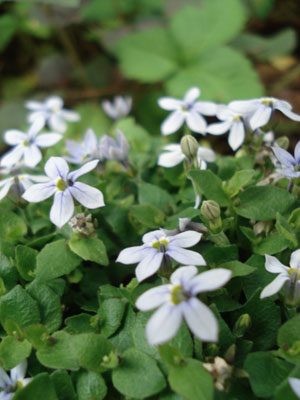
Treadwell's Blue Star Creeper
aka, White Star Creeper
"Nature pleases, attracts, delights,
merely because it is nature.
We recognize in it an Infinite Power."
-Karl Wilhelm Humboldt
(1767-1835)
Ultra-hardy & long-blooming Pratia angulata is often alleged to be synonymous with P. pedunculata, but here's the scoop as I understand it:(1767-1835)
P. angulata is the pale blue nearly white Pratia native to New Zealand, called both Blue Star Pratia & White Star Pratia. Its most commonly offered strain is typically labeled as if it were a named cultivar 'Treadwellii.'
P. pedunculata is a rich true blue flower, native to Australia. Its most commonly offered cultivar is 'County Park' sometimes called, incorrectly, 'Kelsey Blue.'
The ongoing confusion stems from both plants having long been regarded as color vaiations of one species, & the shifting of names of that supposedly-single species by earlier names such as Laurentia fluviatilis, Lobelia fluviatilis, Isotoma fluviatilis, & Isotoma axilaris.
These two allied genera are still sometimes are given, collectively, the common names Laurentia, or "Swamp Isotoma," the latter somewhat a misnomer since they're not swamp plants & do poorly if continuously wet, but in the comparative sense, an Australian "swamp" in particular can be a verdant location that's merely not a desert.
P. angulata 'Treadwellii' is a miniscule groundcover only an inch or two tall of tiny-tiny soft leaves, potentially humping up to four inches. It has quarter inch to half-inch surprisingly showy five-point-stars dotting the surface of the matt-spreading little plant.
It is sold as a "stepable," which is a bit of an exaggeration because if you step on it, it'll look like hell. The cultivar name 'Treadwellii' sounds like an allusion to its presumed treadability, but it's actually named for Lieutenant-Colonel Charles Archibald Lawrence Treadwell (1889-1966), soldier & author of New Zealand, who wrote a history of the Hutt River.
White star creeper can form a veritable carpet & look like a lawn or moss but with the added bonus of a heavy sprinking of blossoms. It is sometimes recommended as a lawn substitute, but again, though it won't kill it to walk on it, it spoils the flowers entirely & flattens the leaves so not seriously to play on like a lawn.
It is perhaps more practical as an addition to rather than replacement for a lawn, as it is short enough to be missed by the lawnmower, is not killed by sharing ground with a lawn, & by its blossoms can make a well-trimmed lawn look look frosted.
I use it in potted plants as it fills in around the base of a perennial adding to the beauty, & it is compatable with die-back flowering bulbs including trilliums, insuring some liveliness in the pot even when there's no sign of the bulb.
This New Zealand native can be a great groundcover where mostly spring & summer bulbs come & go, but for the one fault of not really suppressing weeds; some weeds are practically nursed by the mat of foliage, & weeding will mean ripping out big patches of the white star creeper.
It first flowers in spring, may stop flowering temporarily, then blooms again mid or late summer & continues flowering until a cold snap stops it in autumn. In winter the little seed pods look like tiny purple fruits.
Despite its occasional name "swamp isotoma" it does not like to be too wet too often. It has average water needs, moist soil but not sloppy wet. It's adaptable as to soil type but loamy acidic loose soil works for us. It'll spread over a more packed soil but wiill be more delicate & easily messed up.
In rich soil it spreads swiftly to fill a confined space but is too small to displace anything in its path. It's good for path edging & conceivably between pavers if not actually walked on. If the pavers are well-raised & the blue star creeper protected from actual foot-contact in trough-like cracks, it'll do splendidly, & unlike most other between-paver plants, it does not climb onto the stones to hide them, as it only creeps over soil.
It's hardy even under adverse conditions, but generally only beautiful when not experiencing adversity. Dappled sunlight, especially inland, is better than full sun because if it dries out too often in full sun, it won't look its best. But with too much shade it may not bloom well.
Evergreen where winters are exceedingly mild, it does partially die back on us, but returns swiftly at first hint of spring. It is ideal for zones 7 & 8, but stretchable to less than ideal climates, especially at the colder edge, though it loses its semi-evergreen potential.
Marketing has pretty much stabilized its common name as Blue Star Creeper or White Star Creeper, though it has been known by many names, including Lawn Lobelia, Fragrant Carpet (though it isn't fragrant), Creeping Pratia, Panakenake, Laurentia, & Isotoma, only the latter two still likely to be used.
The leaves are edible, a mite lettucy, but too small to be especially practical. Certainly slugs & deer like it, but hardy thing that it can be, it is not much slowed down by being munched upon.
See also:
Pratia pedunculata 'County Park'